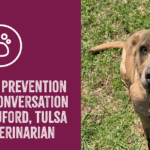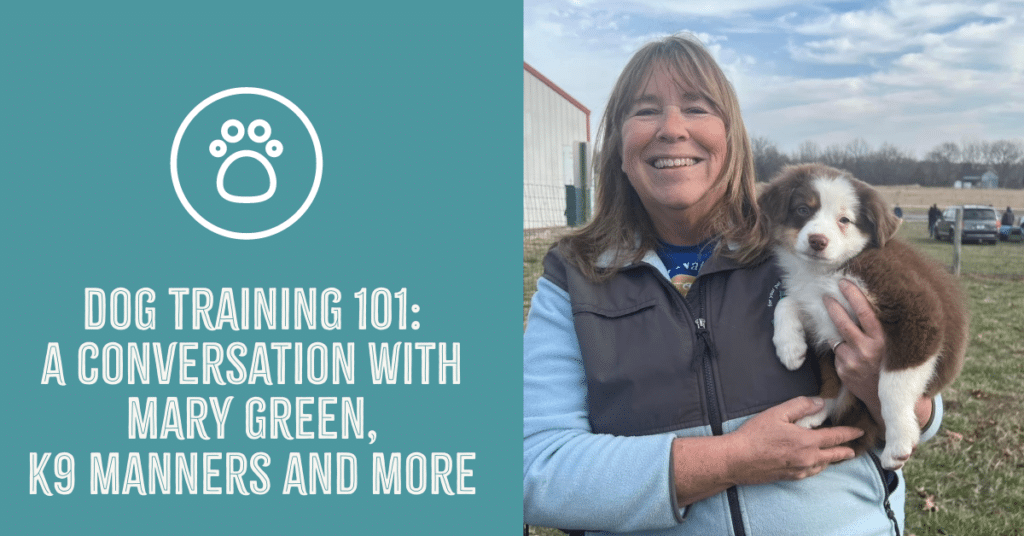
Tim Geen: A Career of Incredible Service
December 30, 2023
Pet Poison Prevention Month: A Conversation with Dr. Buford, Tulsa SPCA Veterinarian
April 2, 2024
Included in this conversation are Mary Green, CEO of K9 Manners & More, and Kyle Paddock, Director of Marketing and Communications for Tulsa SPCA.
This conversation is condensed for the sake of length, but covers the majority of topics discussed.
Kyle: Mary, it’s so good to sit down and talk with you!
Mary: Same to you, Kyle!
Kyle: Could you please tell our readers a little bit about yourself?
Mary: Sure. So, I always had a passion for training dogs. I was that kid who brought home every stray dog in the neighborhood. I would put shoelaces around their necks to help bring them home. I started with a corporate job for many years and when that no longer worked for me, I decided to explore my passion further—which was a really long time ago, around 2001.
Kyle: Can you believe that was 23 years ago?
Mary: It’s surreal sometimes. Where we are now in a 30,000 square foot facility on 2 acres, allows us to do a great many things. We’ve been here since 2011 and have expanded from there. We do family manners classes, behavioral counseling, and one of our trainers is a Pet Parent Educator! She is a super resource for families with babies and toddlers on how to keep everyone safe. We find that is such a common time when people will look to rehome a dog. Sometimes it’s familial pressure, but most of the time it’s just not knowing what to do so this is a great resource for young families. We also do fun things—well, I think it’s all fun—like agility, dock diving, scent work classes (like aromatherapy), among other things.
Kyle: I would never have thought there would be so many diverse options for people!
Mary: We believe training is for the life of the dog—not one and done. Just like our own education. You don’t wake up one morning and decide “well, I’m done!”
Kyle: Most days, I would agree with that, ha! We do get a lot of questions here at Tulsa SPCA about basic dog training. While this isn’t something Tulsa SPCA offers as an in-house service, we of course do offer resources. I wonder if you could give some tips to our readers—like a dog training 101.
Mary: Absolutely! The biggest thing is—well the #1 issue people have is dogs jumping up on them. They just want to get as close to your face as they can. Some of it is mugging—grabbing at your clothing, more unfriendly greetings. But other times it is overzealous greetings. If there is one command or cue that I would encourage all dog owners to teach their babies it is sit. This solves most of the issues with jumping—it’s a lack of impulse control. The hard thing is to train people to abide by this because we tend to encourage it more often than not which can be detrimental. We need to turn that around so that they get this attention when they sit. Another one that leads to dogs running loose and getting picked up as if they were strays is simply not coming when they’re called.
Kyle: Absolutely, and then people are nervous about what to do when they find a dog, like do they trap them, do they try to get them to come, the unknown can be potentially scary. They don’t want to infringe on that personal space.
Mary: Yes, especially if they bite out of fear. So this is why we want people to train their dogs to come when called so if they ever do get the zoomies away from their home, it’s an easy correction.
Kyle: So should we shout their names like we do with our children?
Mary: We want to make a positive connection with their names—so with my dog Wendy, I don’t say “Wendy, get over here right now!” Instead I might say “Wendy, come!” in an almost silly, singing way to associate positive energy instead of anger. It’s a check-in behavior, and people ought to reward this! Rewarding can be giving treats, extra love, and play time.
Kyle: OK, so what about those folks like me who want to make every second play time and muddy the water with no distinction?
Mary: That’s a great question, Kyle, because there really shouldn’t be a distinction. I don’t want Wendy to think, “oh now it’s training time” and avoid me like the plague. Ideally it’s all the same with positive reinforcement training so they don’t know the difference! They are ready!
Kyle: That’s brilliant. So here’s a bit of a self-serving question because it relates to one of my dogs. We used to live in Colombia—South America—in a midtown city apartment, and one of our dogs got used to going to the bathroom in a park or even on our balcony which had a drainage system. That was their “backyard.” When we came back stateside, and still sometimes today, she will go inside the house. No matter what we do, I always seem to step on a “surprise” in our closet in the morning when I wake up and well—you can imagine it’s not a great way to start the day. Are we just out of luck?
Mary: I am still a big advocate of crate training. Freedom is earned with good behavior and house training in this situation is incomplete. An adult dog normally doesn’t need to go outside in the night if they have had their walk or whatever they do before bedtime. If you’re not sure if they are wandering, add some charms to their collar so you hear if they are wandering. Adding a way for her to indicate when she goes outside is also helpful. You could buy a cheap dollar store wind chime that rings every time she gets near it to go outside. Add some peanut butter or spray cheese and they will lick it and go from there.
Kyle: That’s a great idea. We might even be humanizing her too much because we have thought she is just saving a little something extra for us when she gets angry and wants to leave us a message. Are we crazy for thinking this?
Mary: No, not at all! We do humanize our dogs, and we are finding out more and more that they have emotions like we do. They are usually more honest than humans; they don’t try to deceive you. A smart dog will figure out if they ring the chime and go outside, they get a treat so they will do this 47 times a day. In cases like this, I stop rewarding every time and it becomes random.
Kyle: Well this gives me a lot to try. What about negative stereotypes about training—are there some things we really shouldn’t be doing when training our dogs?
Mary: That’s a great question. Going back to housetraining, it did not used to be out of the ordinary for some people to rub their dog’s noses in the area where they did their business inside.
Kyle: Oh no!
Mary: Yeah, that’s a thing! Or they will swat them with a newspaper or with their hands—hitting should never, ever be an option. It’s so damaging to the human-animal relationship and it causes the dog to be sneakier. Another thing that people do is look for the easy way out or a one stop training hack. The reality is there aren’t any! I think we have to remember that everything takes time, repetition, and good practice. One example would be shock collars. This is an immediate, painful solution to a problem that requires none of these things and should not be a viable option by any means. We have to change our overall mindset.
Kyle: Definitely. This makes me think of an article I read in The Atlantic recently that talked about how our culture by and large is a culture of convenience. We want things now–like buy now, pay later, and if things are not immediately fixable we become overwhelmed and throw in the towel.
Mary: Certainly. Going back to the shock collar example, all this accomplishes is suppressing a bad behavior instead of rewarding a good behavior. This is exactly the wrong approach to find out why something is happening.
Kyle: Tell us about your experience with rescue dogs. I think a lot of people expect them to be less trained and more of a hassle, but you and I both know this is not usually the case. I mean, what would you say to people who adopt from Tulsa SPCA or another animal welfare organization to look for as far as training and behavior?
Mary: Sure. Personally, I have 2 dogs that are rescues and 2 that did not come from a shelter, and I approach them in exactly the same way to set a good foundation. Having been in the animal welfare world for over 20 years, there is such a difference with the type of dogs in shelters now. When I started out, most of the dogs in shelters were strays—picked up on the street. Today, we see far more owner surrenders. Now, this could have been from a behavioral standpoint or a lack of resources or what have you. So, this means there could be a wide variety of temperaments. People tend to gravitate towards the shy dogs in need of love, which is wonderful. But they don’t realize that they require much more socialization training and to be eased into a new environment. Not so much with well-socialized dogs who just want to play all the time. You need to know what your personality is and try to match that with the dog you adopt.
Kyle: It’s so funny you say this because our Pet Care team are often like matchmakers. I can’t tell you how many times I have seen them match a person to a dog or cat having just met them and it is a perfect fit. That is almost a divine talent, I think.
Mary: It sure is!
Kyle: You know, one thing I am curious about is this sense of shame I think many people feel when they even think about returning or rehoming a dog, especially if the reason is behavioral. Do you think this shame is warranted, and that it could potentially make people less likely to seek out training and resources?
Mary: No, absolutely not. I don’t think shame is ever warranted and that we need to forgive ourselves. Obviously if there is abuse, that is a different story. But it is so important to find that right home for the dog. Even here at K9 Manners, people will tell us, “I feel like a failure” if they have not been able to train their dog like they think they should have. This sense of shame can be so damaging. We have so many examples of clients who thought about rehoming not because of the dog, but because they feel shame in not having trained them properly and they are also afraid to ask for help. Once they do, in most cases, the problem is solved.
Kyle: It almost sounds like dog training can be therapeutic to both the dogs and the humans, or am I off base?
Mary: Not at all—that’s exactly right.
Kyle: Lastly Mary, I’d like to talk about the perception that dog training is for the one percenters and not for folks with average incomes. Is this a perception you see, and if so, how can we remove that barrier?
Mary: Yes, there is definitely a perception and a lot of it is due to bad info out there filled with false promises. Again with quick fixes—someone may say for $2,000, they can fix an aggressive behavior in 5 days. I think a lot of people think this is par for the course with dog training when in reality, it’s the outlier. We offer–and a lot of places offer– affordable training sessions that are accessible. Wherever you live, there are affordable options with positive trainers out there. Don’t give up or count yourself out!
Kyle: Mary, thank you so much for sitting down with me today to discuss this important subject. I sure learned a lot and I think our readers will, too!
Mary: My pleasure, Kyle. Anytime!


